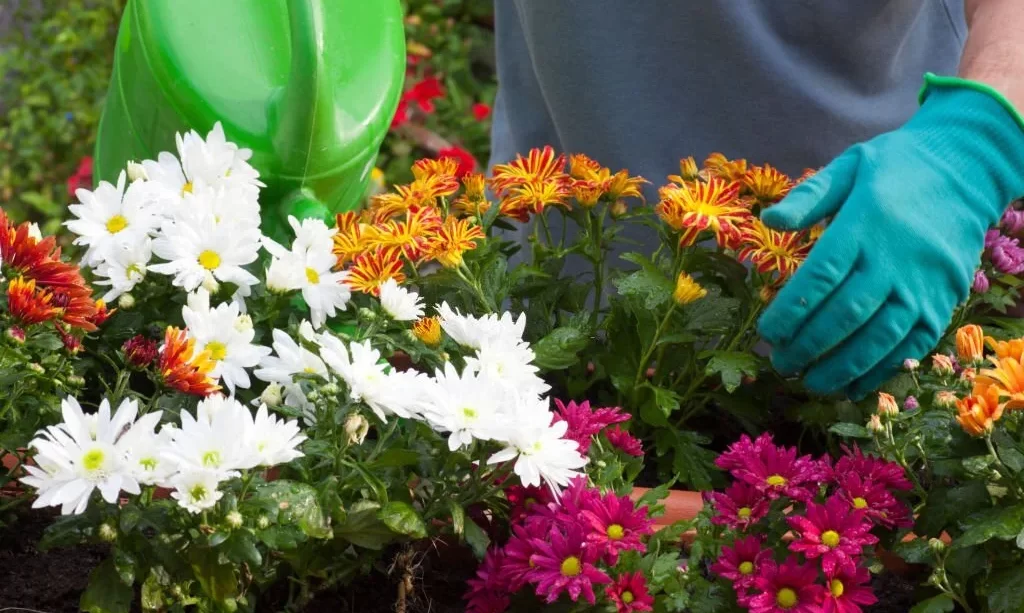Potted mums, with their rich and radiant autumn hues, are a quintessential addition to fall gardens and seasonal décor. Their vibrant blossoms evoke the spirit of the season, but to ensure these mums remain a centerpiece of your garden’s beauty, proper care is essential. Among the critical factors for nurturing healthy potted mums, none is as crucial as watering. In this guide, we delve into the art of watering potted mums, helping you understand the delicate balance between too much and too little moisture. By the end, you’ll be equipped with the knowledge needed to keep your potted mums flourishing and displaying their vibrant colors throughout the fall season.
- 22-5-16 Analysis – Great for providing iron to garden mums and iron loving, warm weather plants, even if the pH rises during the crop cycle.
- Water-Soluble Powder – Powdered concentrates go further than liquid fertilizers. Simply mix your measured powder with water and you are ready to feed with multiple gallons of liquid fertilizer!
- Micronutrients – Added micronutrients supply your plant with the nutrition it needs for optimal growth and health. Unlike other fertilizers, additional feeding is not required.
- Continuous Liquid Feed Program – Intended for use with hydroponic systems. Mixing instructions by volume included.
- Fertilizer appearance may vary in color due to variation in raw material size and tracer dye distribution upon the particles in the bag.
Potted Mums’ Watering Needs
To water potted mums effectively, you must first grasp their unique watering requirements. These lovely plants have a preference for consistently moist soil, but they despise standing in waterlogged conditions. Therefore, the choice of pot and potting mix is pivotal. Potted mums thrive when planted in containers with excellent drainage, allowing excess water to escape easily and preventing root rot, a common ailment in waterlogged soil.
In addition to drainage considerations, external factors like the climate in your region, the size of the pot, and the quality of the potting mix all play roles in determining how often and how much to water your potted mums. Understanding these variables will help you navigate the delicate balance of moisture that these charming autumn bloomers demand.
Signs That Your Potted Mums Need Water
Knowing when your potted mums are thirsty is a skill that can make all the difference in their health and appearance. These are the telltale signs that your mums need a drink:
- Drooping Leaves: When potted mums are in need of water, their leaves will start to droop or wilt. This is a visible indicator that the plant is under stress due to lack of moisture.
- Dry Soil Surface: Gently stick your finger into the soil about an inch deep. If it feels dry at this depth, it’s a sign that it’s time to water. However, if it still feels moist, you can hold off on watering for a bit longer.
- Lightweight Pot: Lift the potted mum carefully. If the pot feels noticeably lighter than when it’s well-watered, it’s a sign that the soil has dried out, and the plant is thirsty.
- Yellowing Leaves: Yellowing or browning of leaves, especially those lower down on the plant, can also indicate dehydration. When the soil lacks sufficient moisture, the plant may start shedding leaves to conserve water.
Frequency of Watering
The frequency of watering your potted mums depends on several factors:
- Climate: In hot and dry climates, you’ll likely need to water more frequently. Conversely, in cooler and more humid conditions, watering can be less frequent.
- Pot Size: Smaller pots dry out more quickly than larger ones since they have less soil to hold moisture. Consider the size of your pot when determining your watering schedule.
- Plant Size: Larger mum plants generally have larger root systems and may require more frequent watering than smaller, recently potted ones.
- Potting Mix: A well-draining potting mix helps prevent overwatering, but it also means that the soil may dry out faster. Check the mix’s moisture-holding capacity to gauge watering needs.
While it’s helpful to have general guidelines for watering, it’s equally important to adapt your schedule to your specific conditions. Regular observation and responding to the signs your mums give you will help you strike the right balance and keep your potted mums healthy and thriving.
- Versatile Potting Soil: Let your plants grow healthy and strong with this general purpose potting soil featuring a blended formula that works for all kinds of greens you plant in it
- Indoor and Outdoor Use: Whether in flower pots, raised garden beds, or other planters in and out of your house, this organic potting soil can maintain optimal use anytime, anywhere at home
- Moisture Retention: Garden soil designed to retain sufficient moisture to sustain active plant growth during moderate dry spells and other dry periods that would harm your plants’ growth
- Blended for Growth: Features a dark blend of reed sedge peat, organic peat moss, and other materials to support plant growth while firmly rooted in this succulent soil
- Bag Specifications: Dimensions: 3.50”L x 21.50”W x 15.30”H; Weight: 20 lbs; Upon receiving the package, indoor potting soil is ready to use out of the bag with zero additional mixing
Watering Techniques
Proper watering techniques are essential to ensure your potted mums receive the moisture they need without causing stress to the plant. Here are some effective watering techniques to keep your mums happy:
- Water at the Base: Direct your watering efforts at the base of the mum plant, avoiding wetting the foliage. Wet leaves can lead to fungal diseases, so it’s best to keep them dry.
- Use a Watering Can: A watering can with a spout or a gentle spray attachment allows for precise and controlled watering. This prevents soil erosion and splashing onto the plant.
- Soaker Hose: If you have several potted mums, consider using a soaker hose. It delivers a slow, even stream of water directly to the soil, ensuring thorough hydration without the risk of overwatering.
- Mulch: Apply a layer of organic mulch, such as wood chips or straw, around the base of your potted mums. Mulch helps retain soil moisture, reduces water evaporation, and acts as insulation for the roots.
Avoiding Common Watering Mistakes
Avoiding common watering mistakes is crucial in caring for your potted mums. Here are some pitfalls to watch out for:
- Overwatering: One of the most common mistakes is overwatering. Ensure the soil is drying out between watering sessions to prevent waterlogged conditions that can harm the roots.
- Neglecting Drainage: Ensure your pots have proper drainage holes to allow excess water to escape. Avoid letting pots sit in standing water, as it can suffocate the roots and promote root rot.
- Watering Too Shallow: When watering, make sure the water penetrates deep into the root zone. Shallow watering can encourage shallow root growth and make the plant more susceptible to drought.
Conclusion
In conclusion, the key to successfully growing potted mums is mastering the art of watering. By recognizing the signs that your mums need water, adjusting your watering frequency to environmental factors, and employing proper watering techniques, you’ll be well on your way to nurturing healthy and vibrant potted mum plants.
Remember that every garden is unique, and the specific needs of your potted mums may vary. Regular observation and attentiveness to your plants’ signals are essential. With the right watering regimen, you can enjoy the stunning and colorful display of potted mums throughout the fall season, adding a touch of autumnal charm to your garden or home.






